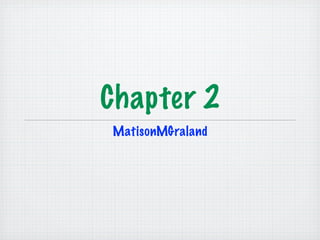
Science keynote chapter 2
- 2. 2.1 vocabulary A pure substance is matter that has exactly the same composition An element is a substance that cannot be broken down into simpler substances An atom is the smallest particle in an element A compound is a substance that is made from t wo or more simpler substances and can be broken down into those simpler substances. In a heterogeneous mixture, the parts of the mixture are noticeably different from one another. In a homogeneous mixture, the substances are so evenly distributed that it is difficult to distinguish one substance in the mixture from another. A solution is when substances dissolve to create a homogeneous mixture. A suspension is a heterogenous mixture that separates into layers over time. A colloid contains some particles that are intermediate in size bet ween the small particles in a solution and the larger particles in a suspension.
- 3. 2.1 Key Content Every sample of a given substance has the same properties because a substance has a fixed, uniform composition. An element has a fixed composition because it contains only one type of atom. A compound always contains t wo or more elements joined in a fixed proportion. The properties of a mixture can vary because the composition of a mixture is not fixed. Based on the size of its largest particles, a mixture can be classified as a solution, a suspension, or a colloid.
- 4. How to Classify Matter Matter No Is it uniform Yes throughout? Heterogeneous mixture Homogeneous No Can it be separated by Yes physical means? Homogeneous mixture Pure Substance (solution) No Can it be decomposed Yes into other substances by chemical means? Element Compound
- 5. 2.2 Vocabulary A physical property is any characteristic of a material that can be observed or measured without changing the composition of the substances in the material. Viscosity is the tendency of a liquid to keep it from flowing- its resistance to flowing Conductivity is a materials ability to allow heat/electricity to flow. Malleability is the ability of a solid to be hammered without shattering. Melting point is the temperature which a substance changes from a solid to a liquid. Boiling point is the temperature at which a substance boils. Filtration is a process that separates materials based on the size of their particles. Distillation is a process that separates the substances in a solution based on their boiling points. A physical change occurs when some of the properties of a material change, but the substances in the material change.
- 6. 2.2 Key Content Viscosity, conductivity, malleability, hardness, melting point, boiling point, and density are examples of physical properties. Physical properties are used to identify a material, to choose a material for a specific purpose, or to separate the substances in a mixture. Filtration, and distillation are t wo common separation methods.
- 7. Solutes and Solvents Solute (dissolved) Solvent (dissolver) Example Air (oxygen in Gas Gas nitrogen) Soda water (carbon Gas Liquid dioxide into water) Ocean Water (Salt in Solid Liquid water) Gold Jewelry (copper Solid Solid in gold) Metals dissolved in metals are called alloys.
- 8. Filtration A process that separates materials based on the size of their particles +/or solubility.
- 9. Distillation A process that separates the substances in a solution based on boiling points.
- 10. Evaporation A process used to isolate a substance that has dissolved in a liquid. Property: solubility
- 11. 2.3 Vocabulary A chemical property is any ability to produce a change in the composition of matter. Flammability is a material’s ability to burn in the presence of oxygen. Reactivity is the property that describes how readily a substance combines chemically with other substances. A chemical change occurs when a substance reacts and forms one or more new substances. Precipitate is any solid that forms and separates from a liquid mixture.
- 12. 2.3 key content Chemical properties can be observed only when the substances in a sample of matter are changing into different substances. Three common types of evidence for a chemical change are a change in color, the production of a gas, and the formation of a recipate. When matter undergoes a chemical change, the composition of the matter changes. When matter undergoes a physical change, the compositon of the matter stays the same.
- 13. Separating water using Elecrolysis When you do electrolysis, the hydrogyn and oxogyn seperate. The compound goes from H20 to H2 + 02. Since that is not possible, you must double the water so the equation looks like this: 2(H2O) and that turns into 2H2 + O2
- 15. What is the difference bet ween a solution, suspension, and colloid?
- 16. What is a physical property? What is a physical change?
- 17. What is a chemical property? What is a chemical change?
- 18. What are the four ways to recognize a chemical change?
- 19. Study Labs as well.
- 20. If you have any Questions, post them in the comment section below!!! Happy Studying!!!
Editor's Notes
- \n
- \n
- \n
- \n
- \n
- \n
- \n
- \n
- \n
- \n
- \n
- \n
- \n
- \n
- \n
- \n
- \n
- \n
- \n
- \n